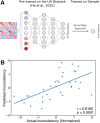Pre-acquired Functional Connectivity Predicts Choice Inconsistency
- PMID: 38508713
- PMCID: PMC11063819
- DOI: 10.1523/JNEUROSCI.0453-23.2024
Pre-acquired Functional Connectivity Predicts Choice Inconsistency
Abstract
Economic choice theories usually assume that humans maximize utility in their choices. However, studies have shown that humans make inconsistent choices, leading to suboptimal behavior, even without context-dependent manipulations. Previous studies showed that activation in value and motor networks are associated with inconsistent choices at the moment of choice. Here, we investigated if the neural predispositions, measured before a choice task, can predict choice inconsistency in a later risky choice task. Using functional connectivity (FC) measures from resting-state functional magnetic resonance imaging (rsfMRI), derived before any choice was made, we aimed to predict subjects' inconsistency levels in a later-performed choice task. We hypothesized that rsfMRI FC measures extracted from value and motor brain areas would predict inconsistency. Forty subjects (21 females) completed a rsfMRI scan before performing a risky choice task. We compared models that were trained on FC that included only hypothesized value and motor regions with models trained on whole-brain FC. We found that both model types significantly predicted inconsistency levels. Moreover, even the whole-brain models relied mostly on FC between value and motor areas. For external validation, we used a neural network pretrained on FC matrices of 37,000 subjects and fine-tuned it on our data and again showed significant predictions. Together, this shows that the tendency for choice inconsistency is predicted by predispositions of the nervous system and that synchrony between the motor and value networks plays a crucial role in this tendency.
Keywords: choice inconsistency; decision-making; functional connectivity; predictive modeling.
Copyright © 2024 the authors.
Conflict of interest statement
The authors declare no competing financial interests.
Figures




Similar articles
-
Rest2Task: Modeling task-specific components in resting-state functional connectivity and applications.Brain Res. 2024 Dec 15;1845:149265. doi: 10.1016/j.brainres.2024.149265. Epub 2024 Oct 10. Brain Res. 2024. PMID: 39393483
-
A functional connectivity-based neuromarker of sustained attention generalizes to predict recall in a reading task.Neuroimage. 2018 Feb 1;166:99-109. doi: 10.1016/j.neuroimage.2017.10.019. Epub 2017 Oct 12. Neuroimage. 2018. PMID: 29031531 Free PMC article.
-
Resting-state voxel-wise dynamic effective connectivity predicts risky decision-making in patients with bipolar disorder type I.Neuroscience. 2025 Jan 9;564:135-143. doi: 10.1016/j.neuroscience.2024.11.024. Epub 2024 Nov 20. Neuroscience. 2025. PMID: 39577688
-
Interpreting temporal fluctuations in resting-state functional connectivity MRI.Neuroimage. 2017 Dec;163:437-455. doi: 10.1016/j.neuroimage.2017.09.012. Epub 2017 Sep 12. Neuroimage. 2017. PMID: 28916180 Review.
-
Functional networks and network perturbations in rodents.Neuroimage. 2017 Dec;163:419-436. doi: 10.1016/j.neuroimage.2017.09.038. Epub 2017 Sep 21. Neuroimage. 2017. PMID: 28942060 Review.
Cited by
-
The Trembling Hand Unraveled: Motor Dynamics and Choice Inconsistency.J Neurosci. 2025 Aug 6;45(32):e1312242025. doi: 10.1523/JNEUROSCI.1312-24.2025. J Neurosci. 2025. PMID: 40592574
References
-
- Afriat SN (1967) The construction of utility functions from expenditure data. Int Econ Rev 8:67. 10.2307/2525382 - DOI
-
- Afriat SN (1973) On a system of inequalities in demand analysis: an extension of the classical method. Int Econ Rev 14:460–472. 10.2307/2525934 - DOI
-
- Andreoni J, Miller J (2002) Giving according to GARP: an experimental test of the consistency of preferences for altruism. Econometrica 70:737–753. 10.1111/1468-0262.00302 - DOI
Publication types
MeSH terms
LinkOut - more resources
Full Text Sources
Medical
